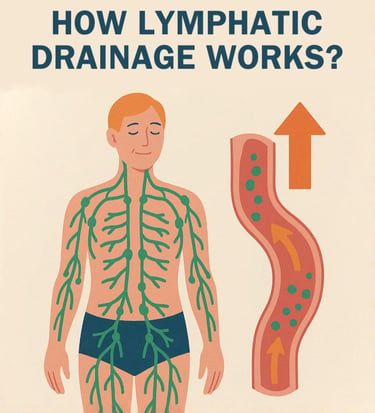What is Lymphatic Drainage?


What is lymphatic drainage?
Lymphatic drainage is a physiotherapeutic technique that activates lymph circulation, helping the body to remove excess fluid, metabolic byproducts, and toxins. The lymphatic system maintains immune protection and internal balance. Unlike classical massage, lymphatic drainage targets the superficial lymph vessels and supports tissue-level drainage.
Lymph movement is facilitated by skeletal muscle contractions, breathing processes (especially diaphragmatic breathing), and the coordinated work of vessel valves. Healthy lymphatic flow is a fundamental aspect of wellbeing; when it is impaired, swelling occurs, immunity drops, metabolism slows, and skin condition deteriorates.
Diet and lifestyle also influence the lymphatic system: evidence shows that certain eating habits and proper fluid balance contribute positively to the body's detoxification functions.
Problems that can arise with impaired lymph flow:
Chronic swelling, heaviness in the legs
Slow recovery after exertion
Occurrence of cellulite and worsening skin tone
Increased fatigue
Reduced immunity
If left unchecked, chronic impairment of lymphatic flow and lymphedema may develop.
Benefits of physiological lymphatic drainage
This method helps reduce swelling, normalize metabolism, stimulates tissue renewal processes, and supports immune status. The influence of breathing techniques on lymphatic dynamics is well-documented, especially for people prone to edema or with a sedentary lifestyle.
A diet rich in vessel-supporting foods and balanced hydration also helps maintain lymphatic health.
Comprehensive lymphatic drainage approach at LoreMeda
At LoreMeda, physiotherapy programs are tailored individually: depending on client needs, device-based therapy, breathing practices, and guidance for healthy eating may be combined. This integrated approach enables effective resolution of current issues and lays a foundation for long-term wellness.
Treatment course
Many notice lightness and reduction of swelling after the first procedure
5–7 sessions are usually enough for a pronounced effect
For chronic issues, a course of 8–10 treatments may be recommended
Ongoing effect is maintained by regularly doing breathing exercises and adopting practical nutrition and activity habits.
Who is it for:
Women, men, and seniors
Those with a sedentary lifestyle or frequent fatigue
Anyone wanting to sustain high energy levels and a feeling of lightness
References
https://pmc.ncbi.nlm.nih.gov/articles/PMC2755111/
Systematic Review of Efficacy for Manual Lymphatic Drainage Techniques in Sports Medicine and Rehabilitation
https://pubmed.ncbi.nlm.nih.gov/38300246/
Manual lymphatic drainage: the evidence behind the efficacy — PubMed
https://www.cancer.gov/about-cancer/treatment/side-effects/lymphedema
Lymphedema and Cancer — National Cancer Institute
https://pmc.ncbi.nlm.nih.gov/articles/PMC11187277/
The rehabilitation efficacy of diaphragmatic breathing …
https://woundsinternational.com/wp-content/uploads/2023/02/content_11070.pdf
Does breathing have an influence on lymphatic drainage?
https://www.lymphedivas.com/blog/nutrition-and-lymphedema-foods-that-can-support-lymphatic-health/
Foods That Can Support Lymphatic Health
https://pmc.ncbi.nlm.nih.gov/articles/PMC9710411/
Dietary supplements in lymphedema — PMC
